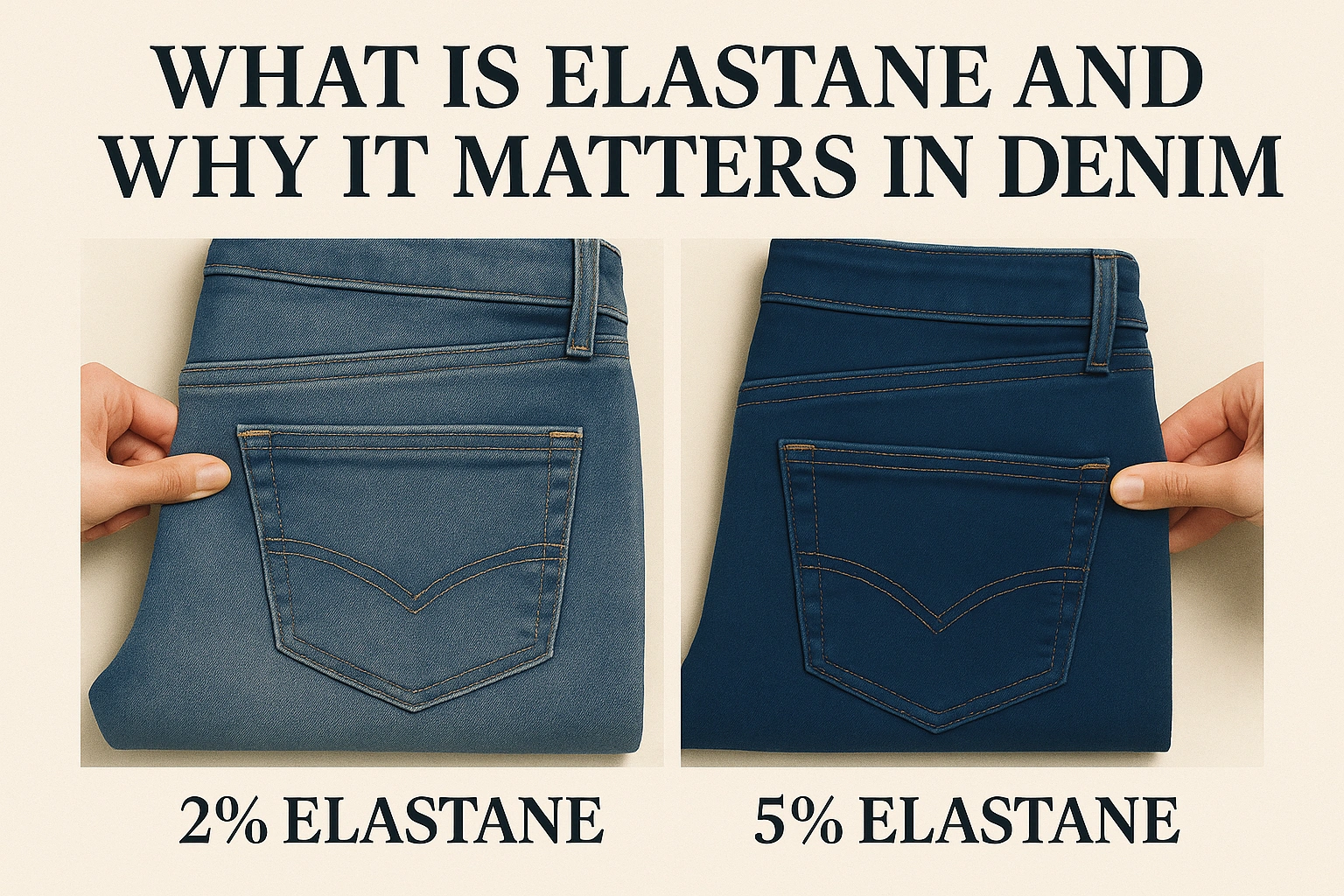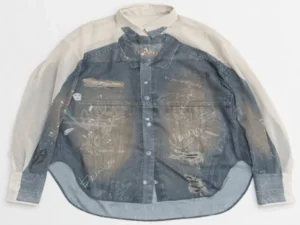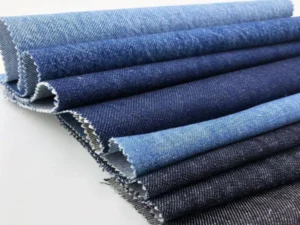In the world of modern denim, stretch is no longer a luxury — it’s a necessity. From office-ready jeans to athleisure-inspired jeggings, performance denim is now a staple across global wardrobes. Behind this flexibility lies one key ingredient: elastane. But not all stretch denim is created equal. The elastane content — whether 2% or 5% — plays a pivotal role in determining how denim behaves, feels, and performs.
In this article, we’ll decode the difference between 2% and 5% elastane in denim, exploring the advantages, disadvantages, ideal uses, and how to choose the right one for your brand or customer base.
These points will be mentioned in the following article
- What is Elastane and Why It Matters in Denim
- 2% Elastane in Denim: A Balanced Stretch
- 5% Elastane in Denim: Maximum Flex and Comfort
- Durability and Recovery: Not Just About Percentage
- Price and Fabric Stability
- How to Choose: 2% vs 5% for Different Customers
- ZEVA DENIM: Your Partner in Performance Denim
1. What is Elastane and Why It Matters in Denim
Elastane — also known as spandex or Lycra®— is a synthetic fiber known for its exceptional elasticity. When blended with cotton or other natural fibers in denim, elastane gives the fabric stretchability and resilience.
Without elastane, traditional denim tends to be rigid, restricting movement. Adding elastane introduces flexibility, improves comfort, and allows jeans to better contour to the body. It also enhances the fabric’s ability to recover after being stretched — a crucial factor in maintaining the garment’s shape.
Elastane is often used in small percentages, typically ranging from 1% to 5%, and even such small amounts can dramatically change the performance and feel of the fabric.
2. 2% Elastane in Denim: A Balanced Stretch
When denim contains 2% elastane, it offers a subtle stretch while preserving the integrity and look of traditional denim.
Characteristics:
* Moderate Stretch Capacity (10–15%)
* Classic Denim Texture Maintained
* Controlled Recovery
* Visual Consistency
* Low Sensitivity to Overwashing

Ideal Use Cases:
* Slim-fit jeans
* Straight-leg styles
* Workwear denim
* Office or daywear
Pros:
* Better shape retention
* Feels more authentic
* Works well for structured garments
Cons:
* Not flexible enough for very active wearers
* May feel too firm for curves or plus-size fits
Example:
A mid-rise slim jean worn by a professional who walks or bikes to work. It provides day-long comfort without compromising sharp aesthetics. The wearer experiences mild stretch when sitting but still gets that crisp, structured look when standing.
3. 5% Elastane in Denim: Maximum Flex and Comfort
Denim with 5% elastane offers extreme stretch and recovery, making it ideal for designs that prioritize comfort, flexibility, and body fit.
Characteristics:
* High Stretch Capacity (30–60%)
* Soft and Flexible Feel
* Form-Fitting and Body-Hugging
* Quick Recovery When Engineered Well
* More Sensitive to Heat and Abrasion

Ideal Use Cases:
* Skinny jeans, jegging-style pants, bodycon dresses, and maternity jeans
* Athleisure-oriented pieces or denim for fitness and travel
* Styles where comfort and body adaptation are more important than rigid structure
Pros:
* Exceptional comfort for all-day wear
* Ideal for shapewear-style jeans
* Allows better fit across different body types
Cons:
* Risk of overstretching or sagging if recovery fibers or construction are poor
* May lose the traditional rugged look of denim
* Requires careful laundering
Example:
A high-rise jegging worn by a traveler who needs comfort on long flights and versatility during excursions.
4. Durability and Recovery: Not Just About Percentage
While the elastane percentage determines stretch potential, fabric construction plays a decisive role in how the fabric performs over time.
Key Considerations:
* Recovery refers to the fabric’s ability to return to its original shape after being stretched.
* High-elastane fabrics without good recovery can sag after a few wears.
* Core-spun yarns (with elastane at the center) are more durable and stable.
* Tighter weaving density helps reinforce structure and shape retention.
This means that a 2% elastane denim made with poor-quality yarn can perform worse than a well-engineered 5% elastane denim with proper recovery properties.
5. Price and Fabric Stability
Elastane is a premium synthetic fiber, so its proportion in denim directly affects cost.
Cost Factors:
* Higher elastane requires advanced spinning and weaving processes
* Quality control is stricter to prevent fabric distortion
* Costs can rise due to higher demand in fashion-forward or performance collections
Care and Fabric Stability:
* More elastane means more sensitivity to heat and friction during washing
* Fabric with 5% elastane is more prone to shrinkage or damage under high temperatures
* Proper washing instructions and consumer education are critical to ensure longevity
6. How to Choose: 2% vs 5% for Different Customers
Choosing the right elastane content is not just a design decision — it’s also about market positioning.
For Fashion Brands:
* 2% Elastane is best for customers seeking structure and minimal stretch. Ideal for timeless silhouettes or denim purists.
* 5% Elastane is perfect for young, active, or body-conscious consumers who prioritize comfort and mobility.
For Wholesalers and Garment Manufacturers:
* Understand your target region. In Europe and North America, 5% elastane stretch denim is growing in demand.
* In more traditional markets, 2% may remain the mainstream choice.
* Analyze feedback on fit retention, return rates, and customer reviews to decide.
7. ZEVA DENIM: Your Partner in Performance Denim
When sourcing denim fabrics with specific elastane compositions, working with a flexible and reliable supplier is key. This is where ZEVA DENIM comes in.
About ZEVA DENIM:
ZEVA DENIM is a leading denim fabric manufacturer in China, integrating R&D, production, and marketing. With over 200 classic and innovative denim fabrics, ZEVA specializes in offering high-performance solutions for global brands.
Whether you need:
* 2% elastane denim with classic textures,
* 5% elastane stretch denim with cutting-edge comfort,
* Or unique blends with specialty yarns,
ZEVA DENIM delivers with:
* Competitive pricing
* Low minimum order quantities (MOQ)
* Fast lead times — typically within 7 days
Their commitment to quality control and fabric innovation makes them a trusted partner for fashion labels, wholesalers, and manufacturers worldwide.
Visit www.zevadenim.com to explore their elastane denim collection and request free swatches.
خاتمة
Elastane is the secret behind denim’s modern reinvention. The choice between 2% and 5% elastane dramatically influences how denim fits, stretches, and recovers — and ultimately, how it’s worn and perceived.

* 2% elastane is the go-to for balance — enough stretch for comfort, without compromising denim’s integrity.
* 5% elastane caters to modern lifestyles — providing maximum movement and shape-contouring comfort.
However, elastane percentage is only one piece of the puzzle. Yarn quality, fabric construction, and brand intention are equally critical.
When in doubt, work with a supplier who understands not just fiber content, but how to engineer fabric that performs — like ZEVA DENIM. Whether you’re launching a new denim line or upgrading an existing one, the right elastane content could be the difference between an average product and a customer favorite.





